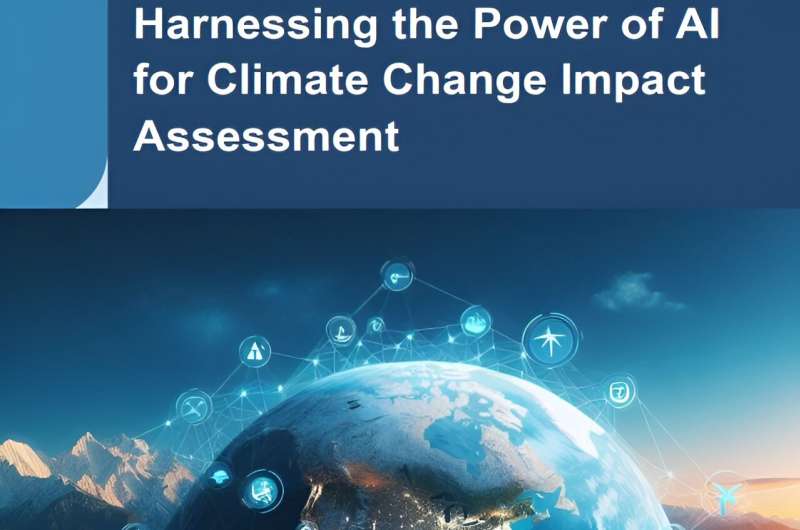
September 6, 2024 by United Nations University
Collected at: https://phys.org/news/2024-09-harnessing-power-ai-climate-impact.html
As climate change continues to intensify, the world is seeing an increase in the number and intensity of climate- and weather-related disasters. The UN member states need to develop urgent mitigation and adaptation actions based on reliable climate change projections.
Obtaining these projections, however, can prove to be difficult. Climate change impact assessment models—the primary means of getting estimates of future climate-related impacts—are complex computational models that require specialized knowledge to run and interpret.
This specialized knowledge and computational requirements are a rarity in many regions and within local communities. This lack of viable impact assessment is putting communities at a disadvantage, making them more vulnerable to climate change.
A new report by UN scientists encourages the global climate action community and the UN member states to consider Artificial intelligence (AI) as a promising solution to this problem. AI is flexible, computationally efficient, and can be run in web- and cloud-based services.
As AI continues to grow in popularity for a variety of applications, it is likely that more people will soon be able to operate and interpret AI output than the traditional climate change impact assessment models.
Yet, AI has not been fully utilized within the climate change impact assessment space. This motivated the researchers of the United Nations University Institute for Water, Environment and Health (UNU-INWEH) to investigate the capabilities of AI by conducting a rapid, flexible, and reliable climate change impact assessment for 46 cities across the United States.
Their results demonstrate the power of this technique to serve as a replacement for conventional climate change impact assessment methods at the local level that are computationally intensive and time-consuming.
“AI is a powerful tool that is being used in nearly every sector, from generating images to medicine, there is no reason why it can’t also be used to build society’s resilience to climate change,” said Dr. Renee Obringer, Research Fellow in Urban and Interdependent Infrastructure Systems at UNU-INWEH, who led this study.
They report projects that there could be increased demands up to 15% for water and 20% for electricity across the 46 modeled cities. Cities in the Midwestern U.S. are likely to experience a median increase in electricity use of 20% after the world surpasses 2.0°C of warming above pre-industrial levels. For the city of Chicago, this equates to 745,000 MWh/month, equivalent to the annual electricity used by over 26,000 U.K. residents, 98,000 Indian residents, or 292,000 Nigerian residents.
In terms of water consumption, the study found that Midwestern U.S. cities might experience an increase of 7.5% after surpassing 2.0°C above pre-industrial levels. Given that the average U.S. household uses over 1,100 liters of water per day, increasing this by 7.5% would result in an additional 85 liters a day per household or 57 million liters a day over the whole city. This is the equivalent of nearly 23 Olympic-sized swimming pools—in just one day for just one city.
Cities in California are expected to see significant increases in electricity demand, but relatively small increases in water demand. But some cities in the Southern U.S. might experience decreases in summer water demand, due to increased precipitation and humidity with climate warming.
In their report, the UN University scientists show how the concept of “climate analogs” can be leveraged to make low-cost projections that are understandable. Based on this concept, they matched each studied U.S. city with another North American city whose current climate matched the best estimate for the U.S. city’s future climate.
For example, their results show that the future climate of New York City most closely matches the current climate of Jonesboro, Arkansas, a southern U.S. city. Leveraging these analogs allowed the researchers to eliminate the need for complex climate models, leading to additional improvements in the accessibility of their AI approach.
Using these analogs is a novel approach that streamlines the process and can be especially helpful for local climate change impact studies. “The analogs reduce the computational cost of the AI impact assessment process and eliminate the need for users to obtain large, complex future climate projections. This is an ideal way for countries, regions, and cities to minimize cost and effort when they lack the expertise and capacity for climate simulations,” said Dr. Obringer.
The authors make several recommendations to expand the use of AI in climate change impact assessment, including the development of web- and cloud-based services that can be especially useful in the Global South. However, the report cautions that AI relies on high-quality, readily available data—an issue in many parts of the world.
Thus, while society aims to build resilience to climate change through equitable mitigation and adaptation policies, it is critical to ensure that the relevant data and models remain open and freely accessible to allow communities to understand their local climate change impacts.
“This report is just a small sample of how the world can benefit from the technological innovations of the Fourth Industrial Revolution to address the equity and sustainability challenges,” said UNU-INWEH Director, Prof. Kaveh Madani.
“AI has its own risks and limits but also major benefits that must not be dismissed, especially when it comes to addressing the digital divide and inequality. Lack of computational infrastructure should not stop the nations from taking proper climate action. AI can help the Global South and underserved communities overcome a major barrier and improve their plans for coping with climate change and extreme events.”
More information: Report: Don’t Dismiss the Great Power of AI for Climate Change Impact Assessment

Leave a Reply